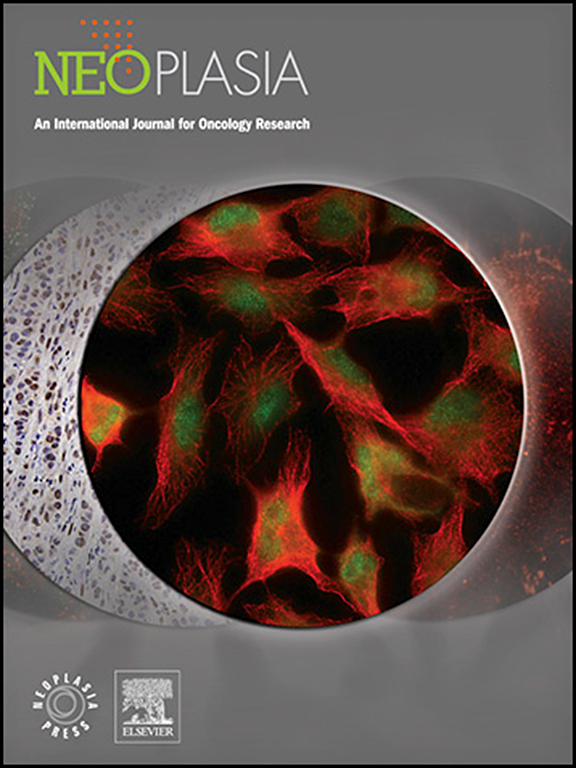胶质母细胞瘤中p16INK4A的高表达与衰老表型和较好的预后相关。
IF 4.8
2区 医学
Q1 Biochemistry, Genetics and Molecular Biology
引用次数: 0
摘要
胶质母细胞瘤,异柠檬酸脱氢酶(IDH)野生型(GBM),是成人中最恶性的脑肿瘤,治疗干预有限。先前的研究已经确定了一些GBM的预后标志物,包括o6 -甲基鸟嘌呤- dna甲基转移酶(MGMT)启动子的甲基化状态、TERT启动子突变、EGFR扩增和CDKN2A/2B缺失。然而,GBM的分类仍然不完整,需要进行全面的分析。在本研究中,我们研究了p16INK4A表达在GBM中的影响,发现p16INK4A高表达的GBM与p16INK4A低表达的GBM相比具有明显的特征。具体来说,p16ink4a高表达的肿瘤细胞表现出衰老表型,并与较高的肿瘤内免疫细胞浸润相关。此外,还观察到GBM中p16INK4A表达升高与患者总生存期延长之间存在关联。我们的体内和体外研究表明,CCL13主要在p16ink4a含量高的GBM细胞中表达。释放的CCL13增强了肿瘤内T细胞的浸润,可能有助于改善p16INK4A高表达患者的预后。这些发现表明,在GBM中具有衰老表型的肿瘤细胞,通过分泌趋化因子如CCL13,可能增加免疫细胞浸润,并可能通过创造更免疫活跃的肿瘤微环境来改善患者的预后。本文章由计算机程序翻译,如有差异,请以英文原文为准。
High p16INK4A expression in glioblastoma is associated with senescence phenotype and better prognosis
Glioblastoma, isocitrate dehydrogenase (IDH)-wildtype (GBM), is the most malignant brain tumor in adults, with limited therapeutic intervention. Previous studies have identified a few prognostic markers for GBM, including the methylation status of O6-methylguanine-DNA methyltransferase (MGMT) promoter, TERT promoter mutation, EGFR amplification, and CDKN2A/2B deletion. However, the classification of GBM remains incomplete, necessitating a comprehensive analysis. In this study, we investigated the impact of p16INK4A expression in GBM and found that p16INK4A-high GBM exhibits distinct characteristics compared to p16INK4A-low GBM. Specifically, tumor cells with p16INK4A-high expression display a senescent phenotype and are correlated with higher intra-tumoral immune cell infiltration. Furthermore, an association was observed between elevated p16INK4A expression in GBM and extended overall survival of patients. Our in vivo and in vitro studies revealed that CCL13 is predominantly expressed by p16INK4A-high GBM cells. The released CCL13 enhances the infiltration of T cells within the tumor, potentially contributing to the improved prognosis observed in patients with high p16INK4A expression. These findings suggest that tumor cells with a senescence phenotype in GBM, through the secretion of chemokines such as CCL13, may augment immune cell infiltration and potentially enhance patient outcomes by creating a more immunologically active tumor microenvironment.
求助全文
通过发布文献求助,成功后即可免费获取论文全文。
去求助
来源期刊

Neoplasia
医学-肿瘤学
CiteScore
9.20
自引率
2.10%
发文量
82
审稿时长
26 days
期刊介绍:
Neoplasia publishes the results of novel investigations in all areas of oncology research. The title Neoplasia was chosen to convey the journal’s breadth, which encompasses the traditional disciplines of cancer research as well as emerging fields and interdisciplinary investigations. Neoplasia is interested in studies describing new molecular and genetic findings relating to the neoplastic phenotype and in laboratory and clinical studies demonstrating creative applications of advances in the basic sciences to risk assessment, prognostic indications, detection, diagnosis, and treatment. In addition to regular Research Reports, Neoplasia also publishes Reviews and Meeting Reports. Neoplasia is committed to ensuring a thorough, fair, and rapid review and publication schedule to further its mission of serving both the scientific and clinical communities by disseminating important data and ideas in cancer research.
 求助内容:
求助内容: 应助结果提醒方式:
应助结果提醒方式:


